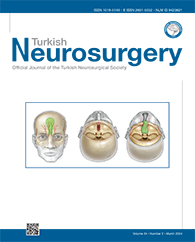2University of Health Sciences Pituitary Diseases Practice and Research Center (PDPRC), Istanbul, Türkiye
3University of Health Sciences, Basaksehir Cam and Sakura City Hospital, Endocrinology and Metabolism Clinic, Istanbul, Türkiye DOI : 10.5137/1019-5149.JTN.46067-23.1 AIM: To share the surgical outcomes of 31 patients who underwent endoscopic endonasal transsphenoidal surgery (EETS) at a single center.
MATERIAL and METHODS: This retrospective analysis of 31 craniopharyngioma cases (2013?2022) with a minimum 6-month follow-up included demographic data, preoperative findings, postoperative resection volumes, recurrence rates, pathological diagnoses, and complications.
RESULTS: Herein, 34 EETS surgeries were performed on 31 patients (12 males, 19 females). The presenting symptoms included visual loss (58%), hypopituitarism (54.8%), and diabetes insipidus (25.8%). Gross total resection was achieved in 87% of the patients, with 64.5% total and 22.5% near-total resection. Total resection prevented recurrences, contrasting with 75% recurrence in the subtotal resection patients (p=0.000). The primary patients showed 73.1% total resection, while only 20% of the recurrent patients achieved it (p=0.049). When comparing the first 16 cases with the last 15 cases in terms of surgical experience, the rates of resection (p=0.040) and recurrence-free survival (p=0.020) in the last 15 cases were statistically significant. Patients with preoperative visual loss demonstrated 94.4% improvement or stability postoperatively. Postoperative complications included hypopituitarism (71.4%), permanent diabetes insipidus (60.8%), worsening vision (6.5%), cerebrospinal fluid leakage (9.7%), meningitis (6.5%), and a 3.2% perioperative mortality rate.
CONCLUSION: This study underscores the role of surgical resection in craniopharyngiomas, emphasizing the impact of surgical experience on recurrence-free survival. Primary surgery, with minimal complications and maximal resection, is crucial in managing recurrence challenges. Endoscopic endonasal transsphenoidal surgery, particularly in experienced centers, offers advantages such as panoramic vision and access to the third ventricle base, facilitating total and near-total resection and extending recurrence-free survival.
Keywords : Craniopharyngioma, Endonasal, Extended endoscopic approach, Recurrence, Third ventricle invasion




